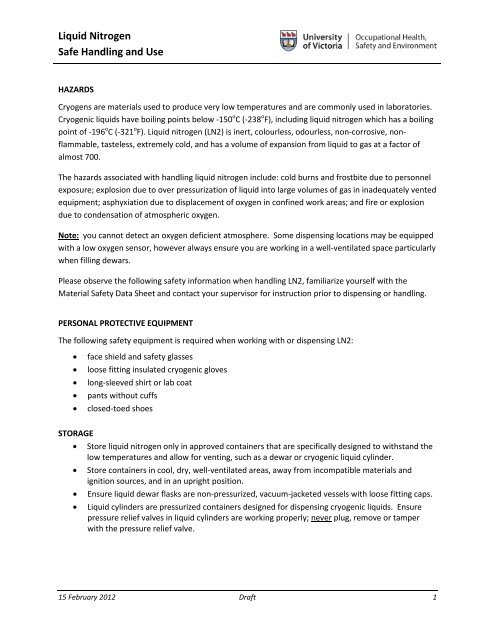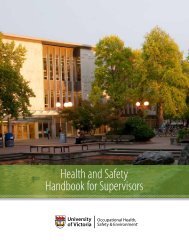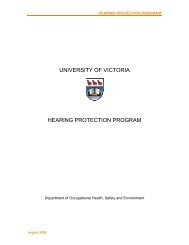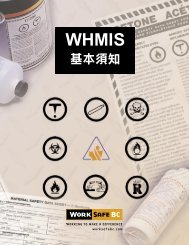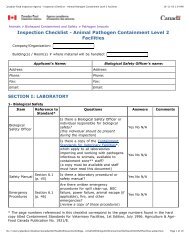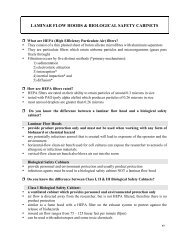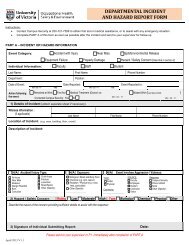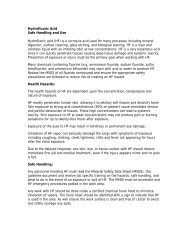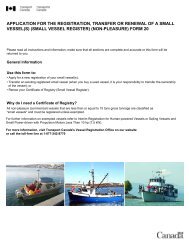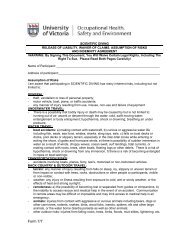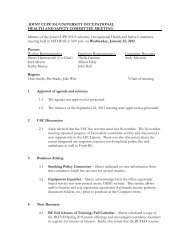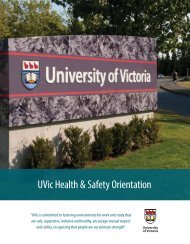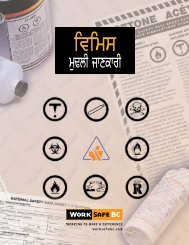Liquid Nitrogen Safe Handling and Use
Liquid Nitrogen Safe Handling and Use
Liquid Nitrogen Safe Handling and Use
Create successful ePaper yourself
Turn your PDF publications into a flip-book with our unique Google optimized e-Paper software.
<strong>Liquid</strong> <strong>Nitrogen</strong><strong>Safe</strong> <strong>H<strong>and</strong>ling</strong> <strong>and</strong> <strong>Use</strong>HAZARDSCryogens are materials used to produce very low temperatures <strong>and</strong> are commonly used in laboratories.Cryogenic liquids have boiling points below -150 o C (-238 o F), including liquid nitrogen which has a boilingpoint of -196 o C (-321 o F). <strong>Liquid</strong> nitrogen (LN2) is inert, colourless, odourless, non-corrosive, nonflammable,tasteless, extremely cold, <strong>and</strong> has a volume of expansion from liquid to gas at a factor ofalmost 700.The hazards associated with h<strong>and</strong>ling liquid nitrogen include: cold burns <strong>and</strong> frostbite due to personnelexposure; explosion due to over pressurization of liquid into large volumes of gas in inadequately ventedequipment; asphyxiation due to displacement of oxygen in confined work areas; <strong>and</strong> fire or explosiondue to condensation of atmospheric oxygen.Note: you cannot detect an oxygen deficient atmosphere. Some dispensing locations may be equippedwith a low oxygen sensor, however always ensure you are working in a well-ventilated space particularlywhen filling dewars.Please observe the following safety information when h<strong>and</strong>ling LN2, familiarize yourself with theMaterial <strong>Safe</strong>ty Data Sheet <strong>and</strong> contact your supervisor for instruction prior to dispensing or h<strong>and</strong>ling.PERSONAL PROTECTIVE EQUIPMENTThe following safety equipment is required when working with or dispensing LN2:• face shield <strong>and</strong> safety glasses• loose fitting insulated cryogenic gloves• long-sleeved shirt or lab coat• pants without cuffs• closed-toed shoesSTORAGE• Store liquid nitrogen only in approved containers that are specifically designed to withst<strong>and</strong> thelow temperatures <strong>and</strong> allow for venting, such as a dewar or cryogenic liquid cylinder.• Store containers in cool, dry, well-ventilated areas, away from incompatible materials <strong>and</strong>ignition sources, <strong>and</strong> in an upright position.• Ensure liquid dewar flasks are non-pressurized, vacuum-jacketed vessels with loose fitting caps.• <strong>Liquid</strong> cylinders are pressurized containers designed for dispensing cryogenic liquids. Ensurepressure relief valves in liquid cylinders are working properly; never plug, remove or tamperwith the pressure relief valve.15 February 2012 Draft 1
DISPENSINGBefore dispensing liquid nitrogen ensure you have the appropriate personal protective equipment,correct fittings <strong>and</strong> hose, receiving dewar, <strong>and</strong> ensure you are in a well-ventilated area. Place thetransfer hose into your receiving dewar, st<strong>and</strong> back <strong>and</strong> slowly open the liquid valve. Proceed slowly toavoid splashing. Do not fill the container more than 80% of capacity. Close the liquid valve whenfinished <strong>and</strong> never leave a filling process unattended.Always use an intermediate-sized dewar (at least 5 litres) when dispensing directly from the cryogenicliquid cylinder. Small, bench-top containers should only be filled from an intermediate dewar <strong>and</strong> neverdirectly from the cylinder to avoid splashing.TRANSPORT<strong>Liquid</strong> nitrogen must be stored, h<strong>and</strong>led <strong>and</strong> transported in an upright position. Do not roll, drag ordrop containers .<strong>Use</strong> an appropriate cart to transport dewars <strong>and</strong> larger containers. Dewars should becovered with a loose fitting cap to prevent air <strong>and</strong> moisture from entering <strong>and</strong> allow for pressurerelease. If you need to move a dewar between floors do not travel with it in the elevator or allowanyone else to be present in the elevator. Instead use a buddy system, signage, elevator lock-out key, orother appropriate means to transport <strong>and</strong> receive the dewar from an elevator.MEDICAL EMERGENCY• If skin comes in contact with liquid nitrogen flush the affected part of the body under warmwater; never use dry heat <strong>and</strong> do not rub the frozen body part. Remove any clothing that is notfrozen to the skin <strong>and</strong> proceed with flushing the skin with warm water.• If the person becomes dizzy or disoriented while working with liquid nitrogen, move to fresh airimmediately.• Call 911 <strong>and</strong> Campus Security at 721-7599 to seek medical assistance.SPILL RESPONSEA small amount of venting is normal <strong>and</strong> ensures the cylinder is relieving pressure build-up. However, ifthe venting seems abnormal or there is a large volume of gas released that cannot be controlled:• Call Campus Security at 721-7599• In case of serious injuries or fire also call 911• If safe to do, secure the area to prevent others from entering• Evacuate the area• Remain near the scene in a safe location• Identify yourself to the Campus Security Patrol Officer upon arrival15 February 2012 Draft 2


